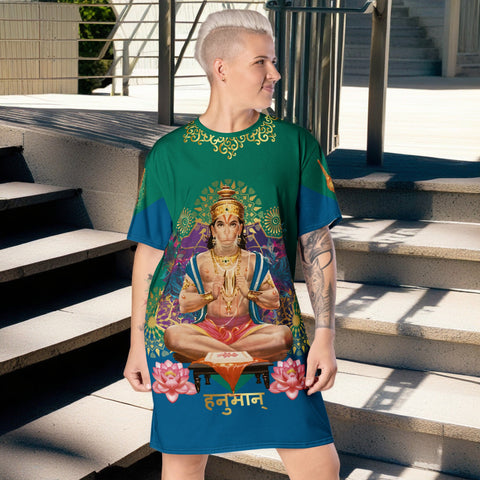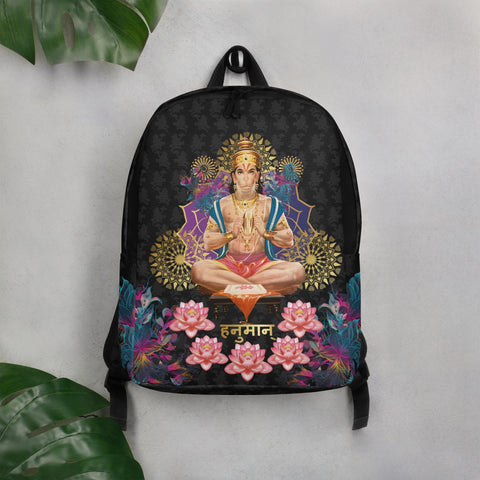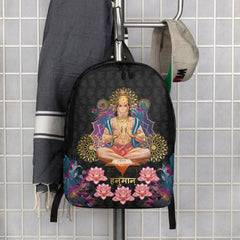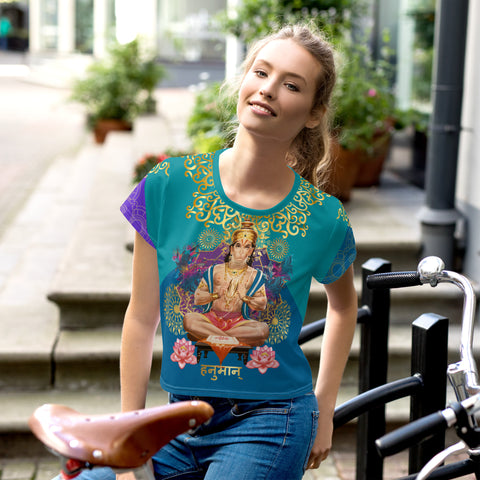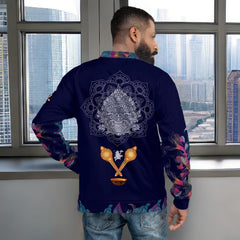All About Hanuman: The Hindu Monkey God and Ramayana Character
Posted by Massimiliano Geraci

In a world filled with diverse cultures and religions, the rich tapestry of Hindu mythology captivates many seeking to understand its pantheon of colorful deities. One figure that often piques curiosity is Hanuman, the revered monkey god whose tales of valor and fidelity resonate across generations.
If you've ever wondered about this enigmatic character who leaps through the pages of ancient scripture with supernatural agility, you're in for an enlightening journey.
Hanuman isn't just any mythic character; he embodies unwavering devotion and strength – virtues that transcend time and geography. He's a beacon for anyone striving to live a life marked by deep loyalty and incredible resilience.
This article peels back layers of legend to reveal who Hanuman is, unlocking his mysteries with each paragraph. From his divine birth to his indelible mark on art and culture, we'll explore how this deity can guide us today.
Ready? Let's dive into the extraordinary world of Hanuman!
Hanuman's Origin and Significance in Hindu Mythology
Hanuman's emergence in Hindu mythology is a tale woven with divine intricacies and profound significance, capturing the essence of unwavering devotion and unparalleled strength. His story begins as a celestial offspring, destined to play an indispensable role alongside Lord Rama in the epochal narrative of the Ramayana.
The Divine Birth of Hanuman
The divine birth of Hanuman intertwines celestial love and cosmic power. Anjana, a beautiful nymph, yearned for motherhood through deep meditation and devotion to Lord Shiva. The wind god Vayu, captivated by her dedication, bestowed upon her a child with his essence—Hanuman.
This unique heritage gave him extraordinary abilities from the very start.
As an infant, Hanuman mistook the sun for a ripe fruit and leapt toward it. This audacious act caught the attention of Indra, king of the gods, who struck young Hanuman with his thunderbolt to thwart what he perceived as a threat to cosmic order.
Despite this heavenly intervention, baby Hanuman survived thanks to his divine lineage—a testament to his resilience and future potential as one of Hinduism's most revered heroes.
Hanuman's Role in the Ramayana
Hanuman's role in the Ramayana is nothing short of pivotal. Loyal servant to Lord Rama, he embodies the ultimate devotee, displaying unwavering dedication and supernatural abilities.
His journey begins with his divine birth as the son of Anjana and Vayu, the wind god, culminating in a fierce warrior who would do anything for Rama’s cause. Charged with finding Sita, Hanuman leaps across oceans and confronts formidable foes without hesitation.
In his most notable exploit, Hanuman leads an army of monkeys to assist Rama in rescuing Sita from the clutches of demon king Ravana. This act alone defines him as a crucial ally in one of history’s greatest epics — but it doesn’t end there.
When Lakshmana is critically injured on the battlefield, it is Hanuman who soars into the sky to fetch a mountain bearing lifesaving herbs to heal him and other warriors during one of ancient India's monumental conflicts.
Fierce battles ensued on Lanka's island where Hanuman played an integral part by decimating many demons within Ravana's legions. With such powerful contributions that shaped events dramatically, he solidified his place among legendary heroes whose tales are recounted through generations across not just India but Southeast Asia too.
Celebrated throughout Hindu teachings for both physical might and moral fortitude, this monkey deity sets forth values like loyalty and courage that resonate deeply within spiritual narratives today.
Next up: Key Attributes of Hanuman – let us explore what makes this majestic figure both revered deity and timeless symbol of devotion.

Key Attributes of Hanuman
Among the pantheon of Hindu deities, Hanuman stands out as a symbol of immeasurable power and unwavering devotion; his celestial lineage and role in epic tales are not just stories but lessons on virtue and strength that resonate with believers worldwide.
His attributes form the core of his character, embodying the perfect balance between might and fidelity—a harmony revered by devotees seeking inspiration to surmount life's challenges.
Personification of Strength and Devotion
Hanuman stands as a towering figure of bravery, unfaltering in the face of adversity. His exploits in the epic Ramayana are legendary, displaying his immense physical power that can move mountains and leap across oceans.
This divine monkey's unwavering commitment to Lord Rama exemplifies an ideal devotee's path – one marked by selfless service and pure-hearted dedication.
Beyond strength, Hanuman also embodies humility and wisdom, qualities that shine through his actions. The Hanuman Chalisa hymns extensively praise these virtues, leading millions to seek his darshan for guidance in overcoming challenges.
The Son of the Wind God, Vayu
Bearing the divine lineage as Vayu's son, Lord Hanuman embodies the formidable prowess of the wind god himself—a power that swirls through Hindu mythology with vigor and vitality.
His genesis weaves a tapestry of celestial influence, for he was no ordinary being but rather a fusion of divine essence and extraordinary potential brought forth by Vayu's mystical grace.
The strength and speed attributed to him are echoes of his father's dominion over air and sky, allowing Hanuman to leap vast distances and carry out feats beyond human capacity.
The legacy passed down from Vayu instilled in Hanuman not just physical might but also a spiritual depth that resonates with devotees across generations. This connection between father and son transcends mere bloodline; it symbolizes an eternal bond within Hinduism where elements like wind become personifications of life force itself.
Harnessing this boundless energy, Hanuman plays pivotal roles in tales that shape the contours of dharma (righteousness) on Earth, next illuminating why 'Significance of His Name' offers profound insights into his character’s essence within these sacred narratives.
Significance of His Name
Hanuman's name carries deep symbolic meaning, directly linked to a transformative event in his youth. The celestial child mistook the rising sun for a ripe fruit and leaped to snatch it from the sky, which led to an altercation with Indra, the king of gods.
In this clash, Hanuman’s jaw was struck by Indra's thunderbolt, resulting in its distinctive appearance. Henceforth known as "disfigured jaw," he embodies traits that go beyond physical prowess.
The resonance of Hanuman's name echoes through centuries of storytelling and worship, embodying unwavering dedication and supreme intelligence. Renowned for his indomitable spirit and clever mind, he stands as a symbol of hope and resilience for countless devotees around the world.
His title magnifies virtues like strength tempered with wisdom—a reminder that names can reflect inner qualities as much as outward features.
Hanuman's Mystical Powers and Curses
Steeped in the tapestry of divine mythology, Hanuman's capabilities extend beyond mere physical might to encompass enchanting mystical powers and intriguing curses that shaped his destiny.
His legendary prowess is not only a testament to his celestial lineage but also intricately woven with tales of amnesia-inducing spells cast upon him, revealing a paradoxical blend of strength and vulnerability within this revered deity.
The Curse of Forgotten Heroism
The Curse of Forgotten Heroism cast upon Hanuman is a fascinating twist in his tale, one that underscores the vulnerability even gods can face. Wise sages once grew furious with young Hanuman for his mischievous use of divine powers and levied this curse, ensuring he would forget them until someone reminded him.
Remarkably, this played into the grand narrative of the Ramayana; it was during a critical moment when others needed him most that Hanuman rediscovered his extraordinary abilities.
His reclaimed might turned tides in epic battles and showcased how moments of crisis could awaken dormant strength. This teaches devotees about inner potential lying in wait for the right spark to ignite.
Next, we explore another aspect of Hanuman's power: His Ability to Change Size at Will.
His Ability to Change Size at Will
Moving beyond the poignant curse that clouded his memory of heroic feats, Hanuman's dynamic ability to alter his physical form at will stands as a striking facet of his divinity. This astonishing power goes far beyond mere myth; it epitomizes Hanuman’s unparalleled agility and strength, central to his role in the epic narrative of the Ramayana.
Able to expand into gigantic proportions or shrink to the size of an atom, Hanuman embodies the perfect balance between immense force and delicate discretion.
Hanuman put this transformative talent to use during critical moments in service to Lord Rama. His size could swell immensely when intimidation or brute force was necessary but could also diminish in an instant, allowing him stealthy access into impenetrable spaces like Lanka - a testament not only to his martial prowess but also to his profound wisdom and self-control.
These shifts in scale are symbolic reminders of Hanuman's adaptability and dedication, qualities that continue to inspire admirers across generations and cultures.
The Worship of Hanuman
The reverence for Hanuman transcends mere admiration, flourishing into daily spiritual practice for millions who find solace in his strength and humility. Chants of the Hanuman Chalisa echo throughout temples as devotees seek blessings and protection, demonstrating a living tradition that celebrates unwavering faith and boundless devotion.
Hanuman Chalisa and Its Importance
Hanuman Chalisa stands as a beacon of hope and faith for millions. This profound hymn, penned by Tulsidas, encapsulates the essence of devotion to Lord Rama. It serves not just as a poetic tribute but also embodies a spiritual guidebook, leading followers on a path towards enlightenment and divine connection.
The forty verses act like a mantra, each one offering protection, strength, and wisdom when chanted with sincere heartfulness.
This powerful composition continues to inspire the bhakti movement today. Devotees absorb its lessons of unwavering dedication and it often acts as the first step for many into the world of spirituality.
Those who recite Hanuman Chalisa find themselves immersed in its rhythmic cadences that resonate deep within their being—connecting them closer to Hanuman's valorous spirit and Rama’s grace.
Its importance transcends mere words; it shapes lives through pure devotion exemplified by Pawan Putra himself.
Temples and Places of Worship
Moving from the rhythmic verses of Hanuman Chalisa to the sacred spaces dedicated to Hanuman, devotees find solace and strength in temples all around the world. Magnificent shrines celebrating his valor are not just confined to India but span across Central, Southeast, and East Asia.
Each temple tells a tale of devotion, featuring vibrant depictions of Hanuman's feats from the Ramayana.
These places of worship act as cultural hubs where artistry meets spirituality. Intricate carvings and murals show Hanuman in various forms—from a fierce warrior to a humble servant—offering insight into Hindu traditions and beliefs.
Pilgrims flock to these spiritual locales seeking blessings for courage and protection, mirroring Hanuman's unwavering loyalty and might that continue to inspire millions across generations.

Hanuman's Influence on Art and Culture
Hanuman's enduring legacy echoes through the vibrant tapestries of art and culture, where his dynamic representations inspire countless forms of creative expression. From temple murals to modern media, Hanuman's visage and valor continue to captivate and influence artistic endeavors across the Indian subcontinent and beyond, enriching both historical narratives and contemporary storytelling.
Depiction in Art and Sculpture
Artists and sculptors have long drawn inspiration from the tales of Hanuman, capturing both his immense strength and unwavering devotion. Sculpted reliefs found on ancient temples across the Indian subcontinent vividly bring to life Hanuman's adventures.
From the powerful image of him leaping over an ocean to reach Lanka, as seen in Indonesian monuments, to depictions of his eight occult powers revered in Tantra, each artwork tells a story from Hindu mythology that resonates with spiritual significance.
The dynamic poses often seen in sculptures reflect Hanuman’s quick wit and physical prowess—traits bestowed upon him by his divine parentage. As son of Vayu, the wind god, these attributes become central elements in artworks spread throughout South India and beyond.
Intricately carved idols capture moments where he uses cleverness or sheer force against adversaries like demon Ravana or when aiding Lord Rama. These pieces serve not only as objects of veneration but also as cultural touchstones that celebrate Hanuman's enduring influence on art and spirituality.
Hanuman in Literature and Media
Hanuman's remarkable journey from a revered mythological figure to a prominent icon in literature and media reflects his enduring legacy. He has been the subject of countless works, ranging from ancient scriptures like the Ramayana and Mahabharata to modern interpretations in books, comics, television series, and movies.
These adaptations often highlight his extraordinary abilities such as flight, strength, and shape-shifting while emphasizing his unwavering devotion to Lord Rama. His tales are not just stories; they act as moral compasses that inspire faith and courage in everyday life.
The image of Hanuman leaping across oceans or lifting entire mountains captivates audiences, planting seeds of wonderment about the power of devotion and loyalty. In today's culture, he transcends religious boundaries, appealing to those who appreciate mythology or seek spiritual enrichment through these narratives.
His incredible feats have been visualized in animations and brought alive on stage through dance dramas by artists inspired by his valor. This transition into various forms of expression has cemented Hanuman's place not only in Hindu tradition but also within global cultural history.
Moving forward with our exploration reveals how festivals play an integral role in honoring this mighty deity’s contributions to Hinduism—celebrations deeply woven into the fabric of Indian culture.
Festivals and Celebrations Honoring Hanuman
Hanuman's unwavering devotion and legendary might are celebrated with fervor during Hanuman Jayanti, the auspicious day marking his birth, which draws devotees from far and wide to partake in rituals and festivities.
Embodying a spirit of joyous veneration, cultural events bloom across regions, notably in North India where grand processions fill the streets as chants praising Anjaneya's glory resound through temples vibrant with offerings and spiritual energy.
Hanuman Jayanti
Celebrating Hanuman Jayanti connects devotees to the divine qualities of strength, resilience, and unwavering devotion as expressed by Hanuman. On this auspicious day in the month of Chaitra, fervent prayers echo through temples while followers immerse statues of this revered deity in sacred baths.
The air fills with chants and hymns praising his celestial birth and heroic deeds from ancient scriptures like the Ramayana.
Devotees honor Hanuman not just in temples but extend their reverence to monkeys in zoos, symbolizing respect for all of Lord Hanuman's forms. Sweets and bananas are offered devoutly as oblations; these acts embody the spirit of bhakti (devotion), a core tenet admired among followers.
The festival also showcases physical prowess—wrestlers and bodybuilders congregate at competitions where they chant "Jai Hanuman" before showcasing their might, drawing inspiration from his legendary strength.
Other Festivals Celebrating Hanuman
While Hanuman Jayanti marks the most significant celebration dedicated to the valorous deity, numerous other festivals across India and beyond pay homage to Lord Hanuman's might and benevolence.
In parts of Northern India, Bada Mangal is celebrated with fervor, as devotees flock to temples bringing offerings and chanting prayers in honor of Hanuman. This festival spans over several Tuesdays during Jyestha (May-June), emphasizing his auspicious influence on this weekday.
Moving southward, in Tamil Nadu, the commemoration known as Hanumath Jayanthi takes place in December or January – Margazhi month according to the regional calendar. Devotees undertake fasts and participate in special pujas at dawn believed to confer protection and strength from their reverent primate god.
On a global scale, communities from Hinduism in Fiji to Bali celebrate Hanuman with local traditions that weave into the fabric of their cultural tapestry.
Hanuman's timeless tale also intersects with Dussehra festivities; effigies of Ravana are burned symbolizing victory over evil - a battle where Hanuman played a pivotal role. Celebrated widely across India, Dussehra stands testament not just to Ram's triumph but also serves as an ode to his devoted companion who was crucial for success.
These diverse celebrations reflect the multifaceted nature of Hindu worship practices and showcase how deeply ingrained Hanuman is within various aspects of spirituality and culture.
His tales continue molding family values while inspiring countless individuals towards physical prowess – cementing his status as a patron deity for wrestlers and bodybuilders worldwide.
Each event throughout the year reaffirms community bonds under his watchful gaze—a true embodiment of unwavering devotion.
Hanuman's Educational Journey
Delving into the depths of Hanuman's educational journey reveals his insatiable quest for knowledge, a path that highlights the value of wisdom and learning in spiritual growth. His time spent mastering scriptures under the sun god's tutelage exemplifies a divine disciple relationship, offering insights into ancient practices of knowledge transmission and mentorship.
Hanuman's Quest for Knowledge
Hanuman's thirst for knowledge was as vast as his immortal strength. His determination to learn shone brightly, leading him to seek the sun god Surya himself as a teacher. The mighty deity saw Hanuman's unwavering commitment and agreed to impart wisdom, making him a pupil.
To gain such profound understanding, Hanuman mastered not just scriptures but also arts and occult practices; he delved into the four sacred books and became versed in sixty-four forms of art.
With every lesson from Surya, Hanuman expanded his mental horizons while never losing sight of his duties—his guru-dakshina embodied loyalty by promising to protect Surya’s son Sugriva.
This educational journey wove together threads of devotion with strands of scholarly pursuits, demonstrating that one can be both disciple and protector on the path to enlightenment.
Through intense study under a celestial mentor, Hanuman exemplified how dedication to learning can coexist alongside heartfelt service.
The Guru-Disciple Relationship
The Guru-Disciple relationship in Hindu tradition is a sacred bond, revered and essential on the path of knowledge. Hanuman's determination led him to seek instruction from none other than Surya, the sun god.
This divine mentorship signified more than just the transfer of wisdom; it embodied devotion, respect, and an unwavering commitment to learning. As Hanuman mastered scriptures under Surya's guidance, their relationship highlighted an important aspect of Hindu spirituality – enlightenment through dedicated mentorship.
Fulfilling his guru-dakshina with loyalty and service, Hanuman committed to protecting Surya’s son Sugriva. This act solidifies not only his role as a disciple but also as a guardian and ally within celestial relationships.
The story teaches that genuine discipleship transcends mere academic pursuit; it encompasses deeds that honor one's teacher beyond the classroom. Moving forward into discussions about health brings us to how Hanuman’s teachings influence yoga practices today.
Hanuman's Connection with Yoga and Health
Hanuman's legacy extends beyond mythological tales, serving as a cornerstone in the practice of yoga and promoting holistic well-being. His embodiment of physical prowess and mental discipline inspires practitioners to integrate these elements into their quest for health and spiritual growth.
Hanumanasana and Its Benefits
Hanumanasana, the yoga pose inspired by Lord Hanuman's giant leap in the Ramayana, embodies strength and perseverance. Practicing this powerful stretch promotes physical balance and flexibility.
It opens the hips, stretches the hamstrings and thighs, fostering an overall sense of well-being. This asana is a testament to overcoming challenges with grace—just as Hanuman did on his path to finding Seetha.
Incorporating Hanumanasana into your yoga routine invites success and protection into your life. The posture echoes the monkey god’s heroic qualities—strength, courage, devotion—and channels them through you.
As you practice this pose regularly, it builds not only muscular power but also mental resilience. Followers believe that like Hanuman defeated Indrajit despite trials, so too can they surmount life’s obstacles with dedicated effort in their yogic journey.
Hanuman: The First Teacher of Pranayama
Hanuman's mastery of pranayama—a key aspect of yoga—is legendary, marking him as a pivotal figure in the discipline’s development. He utilized controlled breathing to enhance his vast array of mystical powers, showing us that the breath is a gateway to both physical prowess and spiritual enlightenment.
Devotees look to him as an exemplary yogi who could control his life force, or prana, with exceptional skill.
Embodying perfect balance and health through these techniques, Hanuman inspires practitioners around the world. His disciplined approach serves as a template for integrating pranayama into one’s daily practice effectively.
As students work on their breathing exercises, they channel Hanuman's essence—cultivating focus, energy management, and inner peace.

Symbolism and Iconography
Within the vibrant tapestry of Hinduism, Hanuman's symbolism and iconography stand as profound signifiers, not merely artistic choices but reflections of deeply held spiritual truths.
His striking depictions ignite curiosity and a yearning to understand the essence behind his red-hued form and the multilayered meanings that each attribute conveys about this revered deity.
Why Hanuman is Often Depicted in Red
Hanuman radiates with the color red, a testament to his unwavering devotion for Lord Rama. The vibrant hue stems from an act of veneration; Hanuman once anointed himself in vermilion to honor Rama's well-being.
This symbolic gesture has been immortalized in his depictions across temples and artwork, reflecting not only his love but also symbolizing courage, strength, and purity which are intrinsic qualities associated with Hanuman's character.
The rich shade of red serves as a beacon of inspiration for devotees who seek to emulate Hanuman’s dedication and bravery. It cements his image as one of unshakeable faith and formidable power among the pantheon of Hindu deities.
Following this visual emblem we explore another aspect integral to Hanuman's iconography: The Five-Headed (Panchamukhi) form that signifies his omnipresence and multifaceted nature.
The Five-Headed (Panchamukhi) Hanuman
The Panchamukhi form of Hanuman is a magnificent embodiment of the god's vast abilities and celebrates his connection to other divine figures. Each head represents a unique trait - courage, strength, devotion, health, and truthful speech.
This five-faced aspect simultaneously depicts important Vaishnavite deities, weaving together profound elements of Hindu belief systems. Enthusiasts often marvel at this complex iconography that unfolds layers of philosophical richness with each contemplation.
Artisans portray this multifaceted deity in vibrant hues that attract onlookers and devotees alike; its representation serves as an artistic masterpiece in temples across India. Moving beyond mere adornment or symbol, the Panchamukhi Hanuman inspires faith and awe in those seeking deeper spiritual experiences.
Next up we explore another compelling facet: The Symbolism Behind Hanuman Tearing Open His Chest.
The Symbolism Behind Hanuman Tearing Open His Chest
Moving from the awe-inspiring Panchamukhi representation, we delve into another profound aspect of Hanuman's iconography: the moment he tears open his chest. This powerful act is a testament to his unwavering devotion, with Rama and Sita residing at the very heart of his being.
It's an image that speaks volumes about the nature of true bhakti—selfless love and surrender.
Hanuman demonstrates that in letting go of one's ego, there lies a path to unity with the divine. His dramatic gesture lays bare not just his physical heart but symbolizes opening oneself up to divine love – a lesson in pure devotion where God becomes more than a belief; God becomes an inseparable part of one’s essence.
For those who hold spirituality close, this depiction encourages looking inward and finding strength in faithfulness and unwavering commitment.

Hanuman's Role as a Protector
Hanuman is revered as a powerful guardian, embodying the strength and valor to shield his devotees from harm; delve into his protective mystique and discover how this divine hero can fortify your own life's journey.
Use of Hanuman in Amulets and Jewelry
Devotees across the globe treasure amulets and jewelry featuring the mighty Hanuman, embracing them as symbols of protection and strength. These cherished items serve not only as spiritual talismans but also as artistic expressions of faith in Hindu culture.
Engraved with his likeness or sacred mantras, such pieces are often worn to invoke Hanuman’s bravery and devotion, hoping to channel his blessings into their own lives. They turn to these tokens during challenging times, seeking the resilience that Hanuman epitomized when he leapt across oceans and mountains out of loyalty to Lord Rama.
Crafting these amulets involves a deep understanding of Hindu traditions and iconography, ensuring each piece carries the powerful essence it promises. Jewelers infuse design elements from ancient scriptures with modern aesthetics—sometimes incorporating precious metals or stones—to create wearable art that resonates with believers’ hearts.
By adorning themselves daily with these items or gifting them on auspicious occasions like Hanuman Jayanti, individuals pay homage to this revered deity while reinforcing their personal kinship with him.
Moving beyond mere decoration, they embody sentiments of enduring courage and unwavering faith. Such practices vividly illustrate how spiritual heritage continues shaping contemporary life choices—a transition seamlessly leading to an exploration of Hanuman's influence on astrological beliefs.
Hanuman's Influence on Astrological Beliefs
Hanuman is venerated for his command over celestial forces, often turning to him for divine protection against malevolent cosmic energies. Believers seek his blessings to ward off the ill effects of unfavorable planetary positions and life's obstacles.
He is seen as a shield, fortifying their spiritual resilience and granting courage in times of adversity. Legends tout Hanuman's ability to bestow positivity, whereby followers gain clarity and focus that lead them through tough astrological transitions.
His devotees entrust him with their prayers when faced with financial hardships or health issues, trusting that his mighty influence will carry them to safer shores. Invoking Hanuman is synonymous with inviting success into one’s life; his presence is believed to alleviate the burdens dictated by stars and fate.
With such faith placed in this powerful deity, it becomes clear why so many include Hanumana worship in their daily rituals for peace and prosperity. The next topic explores how this reverence extends beyond spirituality into physical expressions at temples dedicated to Hanuman across the world.
The Enduring Relevance of Hanuman
Hanuman's timeless lessons of loyalty and perseverance continue to resonate deeply, offering wisdom that transcends eras and invites us to explore his ever-relevant teachings further.
Hanuman’s Impact on Modern Spirituality
Hanuman's influence extends beyond ancient scriptures, shaping contemporary spiritual practices around the globe. His embodiment of strength and devotion inspires modern yoga practitioners who strive to integrate his qualities into their daily lives.
In meditation sessions and yoga studios, followers invoke his energy by performing Hanumanasana, a pose that signifies his mighty leap across the ocean. This physical discipline mirrors the mental fortitude required for deep spiritual growth.
Across various schools of thought in Hindu philosophy, Hanuman remains an emblem of aspirational faith and unwavering commitment. Devotees chant the Hanuman Chalisa seeking inner courage and protection from life’s adversities.
His tale encourages individuals to overcome egoistic tendencies through selfless service, emulating his path to enlightenment as depicted in key texts like Ramayana. The monkey god's legacy thus continues steering seekers towards virtues essential for achieving moksha or liberation in their personal spiritual journeys.
Lessons from Hanuman's Devotion in Today's World
While Hanuman's impact on modern spirituality teaches us to blend ancient wisdom into our daily lives, his teachings offer an even deeper insight into the art of devotion. Embracing the qualities of strength and intelligence that defined this divine figure shows us how to apply steadfast dedication in our own pursuits.
Just as Hanuman combined his might with a sharp mind in service of a higher cause, we too can harness our unique abilities to contribute meaningfully to society.
Reflecting on Hanuman’s unwavering loyalty towards Lord Rama provides a template for relationships built on trust and faithfulness. In today's fragmented world, where commitments can be fleeting, imitating such fidelity encourages stronger community bonds and personal connections.
Lessons from his story inspire us to move beyond self-interest and work collaboratively towards shared goals with both courage and compassion at the forefront.





